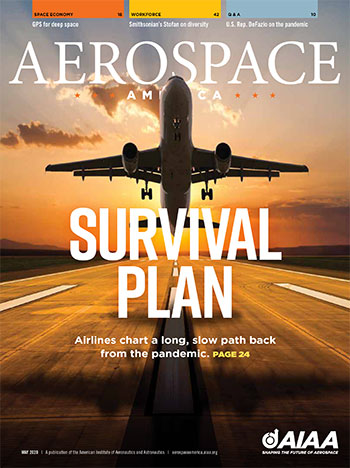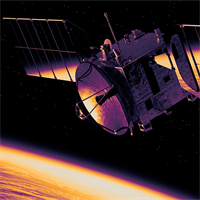Things to Do When You’re a Teleworking Aerospace Engineer or Aerospace Engineering Student
Many aerospace organizations are having their employees work from home to mitigate exposure to the coronavirus and keep communities, especially the most vulnerable members, safe and healthy. AIAA applauds and supports this decision.
We encourage everyone to follow the coronavirus safety guidelines set out by the WHO and CDC.
We understand you still have work to do and may be looking for new ways to connect while you telecommute. We can help.
For the latest updates about AIAA events and forums that have been impacted by the coronavirus pandemic visit: AIAA.org/coronavirus
If you’re a teleworking aerospace professional and have children at home, AIAA has some suggestions to keep your budding aerospace engineer busy.
Have time to update your research knowledge? Aerospace Research Central has more than 50 years’ worth of research papers.

Looking to start a conversation and hash out a technical topic? Go to Engage.
Recent topics include:
- The Potential of Space Tourism
- Looking for mentors for The American Rocketry Challenge
- Best Colleges for Aerospace
Engage community is a benefit of AIAA membership
Want to learn something new or brush up your skills? Sign up for online learning.
Looking to broaden your understanding of the latest issues in aerospace? Read Aerospace America.
Current Issue

The May 2020 issue of Aerospace America is now live. Don’t miss this month's cover story, "Action Plans," by Cat Hofacker. Also, see if you possess the knowledge to solve this month's AeroPuzzler: Surviving the Fall.
Webinars
On Demand Recording Available
 Today’s space industry is rapidly growing so how do we continue to build and expand our off-world future in a more sustainable and deliberate fashion? How can all aspects – environmental, economic, and social – be integrated into present and future space efforts? How do we implement this domestically as well as internationally?
Today’s space industry is rapidly growing so how do we continue to build and expand our off-world future in a more sustainable and deliberate fashion? How can all aspects – environmental, economic, and social – be integrated into present and future space efforts? How do we implement this domestically as well as internationally?
The space industry was NOT created with sustainability in mind
LEARN how sustainability is defined and embraced for space.
DISCOVER how space companies are taking sustainability to the next level.
DETERMINE how to measure what’s working and what’s not.
EXPLORE recommendations on how to sustain the space ecosystem and how that impacts Earth.
The United Nations defines sustainability as “meeting the needs of the present without compromising the ability of future generations to meet their own needs.” The three pillars of sustainability are commonly acknowledged as environmental, economic, and social. All three must be embraced for an ecosystem to prosper and persevere.
The space industry was NOT created with sustainability in mind. At the beginning of the Space Age, longevity of the industry was not considered…that is why we have toxic chemicals that would be left behind in soils and groundwater, orbital debris, the inefficiency of single-use systems, the lack of a sustainable workforce, etc.
Sustainability is defined and applied in many ways in the space industry, and this informative event highlights a number of these strategies. Through a diverse set of case studies, we will share a myriad of sustainability best practices and lessons learned.
Podcasts
On Demand Recording Available
 Today’s space industry is rapidly growing so how do we continue to build and expand our off-world future in a more sustainable and deliberate fashion? How can all aspects – environmental, economic, and social – be integrated into present and future space efforts? How do we implement this domestically as well as internationally?
Today’s space industry is rapidly growing so how do we continue to build and expand our off-world future in a more sustainable and deliberate fashion? How can all aspects – environmental, economic, and social – be integrated into present and future space efforts? How do we implement this domestically as well as internationally?
The space industry was NOT created with sustainability in mind
LEARN how sustainability is defined and embraced for space.
DISCOVER how space companies are taking sustainability to the next level.
DETERMINE how to measure what’s working and what’s not.
EXPLORE recommendations on how to sustain the space ecosystem and how that impacts Earth.
The United Nations defines sustainability as “meeting the needs of the present without compromising the ability of future generations to meet their own needs.” The three pillars of sustainability are commonly acknowledged as environmental, economic, and social. All three must be embraced for an ecosystem to prosper and persevere.
The space industry was NOT created with sustainability in mind. At the beginning of the Space Age, longevity of the industry was not considered…that is why we have toxic chemicals that would be left behind in soils and groundwater, orbital debris, the inefficiency of single-use systems, the lack of a sustainable workforce, etc.
Sustainability is defined and applied in many ways in the space industry, and this informative event highlights a number of these strategies. Through a diverse set of case studies, we will share a myriad of sustainability best practices and lessons learned.
Advocacy
Learn more about aerospace advocacy and reach out to policy makers.
AIAA delivers extensive technical expertise and policy guidance to decision makers at the federal and state levels, serving as a reliable resource on a full spectrum of aerospace issues such as satellite launch systems and technology, commercial space activities, airport infrastructure modernization, hypersonic vehicle technologies, aircraft manufacturing, and cybersecurity threats.


